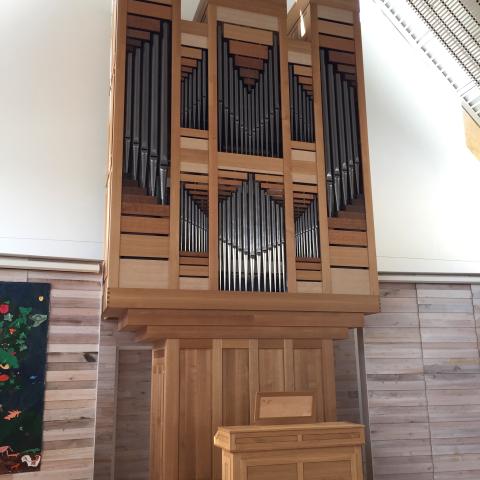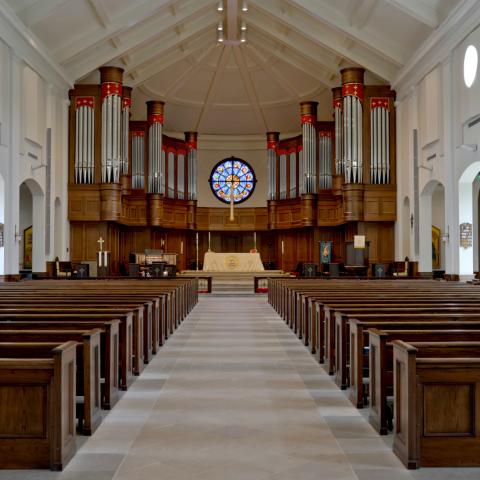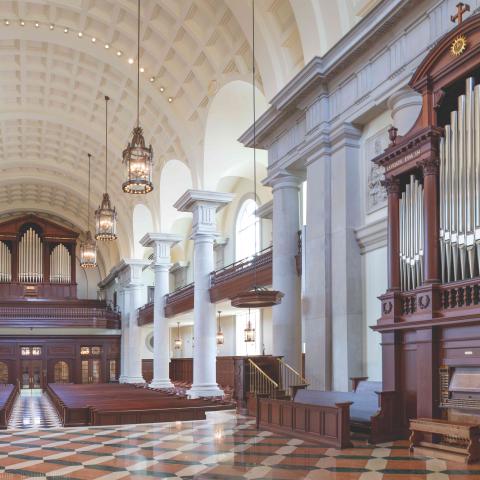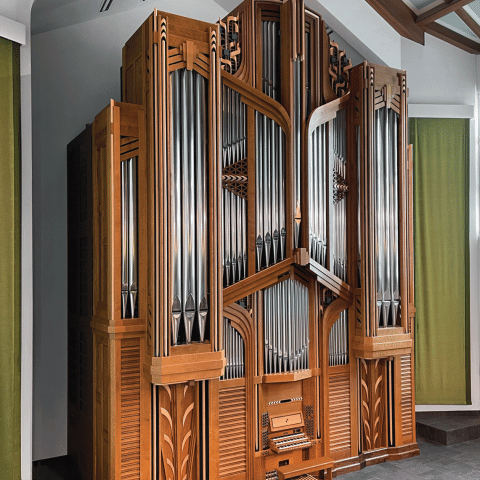Pasi Pipe Organ Builders, Inc., Roy, Washington; Saint George’s Episcopal Church, Arlington, Virginia

From the organ builder
When all the stars line up as they have for this project, a happy outcome is almost a sure thing. Right from the beginning, several years ago, when I was invited to submit a proposal for a new organ at Saint George’s Episcopal Church in Arlington, Virginia, all the different components of a good chance were there.
Dr. Benjamin Keseley sent me a packet of complete information about the building and the music program at Saint George’s and their desire for a new instrument. Following a site visit and meeting with the organ committee, we submitted the proposal with specifications and drawings. The window needed to be preserved in its full glory and there needed to be ample space for the choir. The goal was to end up with a rather complete two-manual and pedal instrument without borrowing between stops.
I would like to take this opportunity to express my deep gratitude to the good people at Saint George’s led by the Reverend Shearon Sykes Williams, rector, who has lent a great amount of support to the music ministry. A special thank you to Dr. Benjamin Keseley, minister of music, always ready to listen and act on the many components that made this project a success. Thank you to the choir, the backbone of a church music program, and all the friendly people at Saint George’s.
None of all this could have happened without the team effort at Pasi Organ Builders, starting with Markus Morscher, long-time right-hand wood guy who ensures smooth operations at the shop and installations; Maurine Pasi, reed pipe maker, carver and general organ builder; Luke Sumerfield, pipe maker; Anthony Balducci, on site installation; David Cason, finish voicing assisting on site; Mark Matters, stop action combination system including wiring.
Thank you to everyone contributing in any way to the successful completion of Opus 28.
—Martin Pasi
From the voicing assistant
I assisted with the voicing of Pasi Opus 28 during the month of November 2021. Part of that experience, unique for an organist, was to hear the instrument come into being in an integral way, a kind of slow-motion evolution. It has been fascinating to hear so many individual voices and colors emerge into a cohesive and artistic whole!
At 33 stops over two manuals and pedal, this instrument includes complete principal and flute choruses in all divisions, colorful variety in foundation and reed voices, and several uniquely colorful stops. Principal choruses have the required brilliance for clarity while the individual tone of the pipes is remarkably warm and vocal in quality; these are plenums with both liveliness and gravitas. The Swell plenum is not secondary to the Great but stands on its own with brilliance and character. Capped and open flutes are available at 8′ and 4′ pitches, and the 4′ flutes are particularly “telling” in the room, giving the cornet combinations remarkable weight. The mutations and 2′ stops simply dance. The Great Trumpet has plenty of brilliance, and like the principals, it is warm throughout its range. The Swell 16′ Dulcian adds transparent warmth and color to the ensemble and is of course a beautiful solo stop. The Swell strings are quite bright, with gentle speech, and carry throughout the room beautifully. Pedal reeds also lend harmonic color while adding to the fundamental presence of that division. The two 16′ Pedal flues—one open, one stopped—complement each other well; the bass tones in the Pedal are present, and never out of balance. (At the conclusion of my time with the organ, the Swell Trumpet and Oboe were not yet in place.)
A few unique features lend even more interest to this already expressive instrument. Most Pasi instruments include an 8′ Suavial, which is tuned as a celeste to the 8′ Principal; the effect is bold and swimming foundation tone. The Quintadena is transparently bright and colorful in contrast to the warm flutes. A rare luxury is the Swell Principal, which is in the façade! Its construction is nearly the same as that of the Great Principal, and its tone is only slightly different. Having both principals in the façade is part of what gives Opus 28 its sense of gravitas, and along with the Pedal Principal, the option to play a Bach trio on balanced and singing principals is more than welcome! These layers of effect, placement, and color from the principals, Quintadena, and Suavial lend the kind of color and variety that we normally only expect from choruses and upperwork. These quieter effects coupled with a responsive action make this instrument imminently expressive; there are layers and layers of color to explore.
Organists who play this instrument for the first time will notice the sensitive action and buoyant acoustic. The overall playing experience is a delight and quite intimate thanks to the proximity of the console to the case; the console is detached, but not distant. At the bench one can hear the room and still sense the immediacy of the action. The console layout is neat and comfortable, with all stops and controls easily visible. The control system is by Pipe Organ Control, which integrates perfectly with the console, with minimal pistons for memory and sequencer control.
I must not omit an obvious first impression for any who see this instrument: the case. The visual impact of this instrument is stunning. Like the tone of the instrument itself, the visual element of the case and façade complements the church without overwhelming the space, a clear testament to the artistry of Martin Pasi and his immensely talented shop of artisans.
Congratulations to Martin Pasi and Saint George’s congregation on this collaboration.
—David Cason
David Cason is organist of Trinity Lutheran Church, Lawrence, Kansas. He continues organ study with James Higdon at the University of Kansas where he earned master’s and bachelor’s degrees in organ performance.
From the minister of music
Saint George’s Episcopal Church is a vibrant, social-justice-minded parish located in the heart of Arlington, Virginia, a few miles from downtown Washington, D.C. The music ministry spans from cradle to grave, offering a graded choir program for children as well as choral and bell opportunities for adults. Music is a cornerstone of the Saint George’s community, from Sunday morning to monthly Evensong, concerts, and informal gatherings.
When I arrived in the summer of 2009, I found a delightful congregation strongly committed to their ministries, including music. The organ was a 1911 Wicks that was reengineered by Newcomer Organ Company and installed into an annexed chamber off the front of a newly built nave in 1952. At two manuals, 25 stops, and 27 ranks, the organ received minor reconfigurations throughout the years. In the past twenty years it had fallen into disrepair, not because of neglect, but simply because it was not designed to last for that long. The console and switching system were in a very fragile state. There were also fundamental design flaws: its scaling was too small for the room, and a floor level placement meant the pipes spoke directly into the choir’s ears. Despite these things, the organ sounded remarkably better than it deserved because the room’s acoustic was quite good.
With the arrival of a new rector in December 2010, the parish soon began to address the need for an updated and accessible worship space. The church recognized that the organ and room were linked: changes to one affected the other. An organ committee was formed to work alongside the renovation committee to evaluate the organ and determine how to best support the needs of a growing and dynamic music ministry. After receiving a thorough education in organ building, the committee commissioned an independent review of the instrument from John Santoianni, curator of organs at Duke University, to supplement their own review and study. The vestry unanimously agreed with John and the committee’s conclusion that building a new instrument would yield the most successful result, and in the long run be the most cost-effective path forward.
The committee continued their work visiting many organs from electronic to hybrid to electric-action and mechanical-action instruments. Through this extensive survey and research, they determined that a mechanical-action instrument would be the best choice for the church. After soliciting proposals and interviewing several organ builders, the committee and vestry chose Martin Pasi. His proposal was for a two-manual, mechanical-action instrument of 33 stops, 39 ranks, with a detached console. The committee was impressed by Pasi’s approach to organ building and the fine attention to detail in all aspects of his instruments.
As an organist who knew Pasi’s work, I was thrilled with the choice. I have played several of Pasi’s instruments and have been impressed with the responsive action, the quality of stops rich in fundamental tone, and the lyrical voicing—and his organ cases are beautiful.
While the organ committee did its work, the renovation side of our project focused on the redesign of the nave to provide an accessible altar and space. Plans for the choir area were designed in conjunction with Martin’s design. This allowed us to prepare a proper seating area for the choir with clear sight lines to the organ console, construct steel floor supports for the organ, design in-floor heating so that it was not under the organ or other instruments, and provide proper humidification and future electrical connections for the organ.
From the very beginning of these projects, I insisted that Saint George’s retain the services of an acoustician. Having experienced the exceptional results of Bob Mahoney’s work at Bales Organ Recital Hall at the University of Kansas, I knew this was essential to a successful space renovation. We hired Bob to guide our process and committed to having acoustical considerations be one of our core principles for the renovation. I was pleased that the parish quickly understood addressing these considerations at each step of the journey, while not inexpensive, would yield invaluable results. We were thankful for Bob’s approach to acoustical design that sought to tune the building acoustic for music and treat the spoken word with technology. To this end, the church installed a Meyer line-array column speaker that successfully allows for the spoken word to be understood clearly in a reverberant space.
Acoustical modifications to the room included the installation of a new silent HVAC system, complete with tunneling large, insulated ducts under the floor to move large quantities of air slowly. Care was taken to ensure air returns were at a significant distance from air supply to reduce noise. All HVAC systems were designed to noise criterion 25.
Further acoustical upgrades to the building included the addition of an inch of solid wood to the nave ceiling to increase bass response and filling voids in the plaster walls of the chancel with high density foam insulation to create a solid mass. The old chamber that would be used for the Pedal division was strengthened with double layers of sheetrock placed on studs eight inches on center. Cavities were filled with high-density foam.
A new ceiling was constructed above the choir area with a sawtooth design to help move sound out past the proscenium arch. This ceiling design proved extremely effective. Final acoustical tests reaffirmed our acoustical work was highly successful with a new reverb time of over four seconds (before organ installation) and a significant increase in bass response. This was all one could hope for in a simple room from the 1950s that seats 300 people. The tremendous results of the room’s acoustical modifications have enabled our new organ to speak in a very relaxed and free manner.
The installation of the organ was a joyous occasion for the people of Saint George’s with nearly fifty people, aged 4 to 92, carrying in many parts of the organ on a Sunday afternoon in early October 2021. The parish support for and excitement about this organ is broad and infectious. This beautiful instrument will support our needs for leading congregational singing, accompanying the choir, and playing of a wide range of organ repertoire for generations to come.
Opus 28 is a sheer joy to play. From the quality of its sounds to the vocality of its voicing, soulful winding, and exquisite action, this instrument sings. I am continually impressed with each stop’s ability to function well both in solo and ensemble roles. It is efficient and plays like a larger instrument. The layout of this organ makes it an exceptional tool for teaching about all aspects of the organ, including construction, design, and winding (with its optional foot-pumped bellows). It is an instrument that teaches you how to play.
I commend Martin and his team for their exceptional work. We are thrilled to be a part of the Pasi family and blessed to count Martin and his associates a part of our community. They brought forth a beautiful instrument of praise for the worship of God. This project is a fine example of the perfect marriage of room and instrument, and we couldn’t be happier. We look forward to sharing it for years to come. Soli Deo Gloria!
—Ben Keseley
Minister of Music, Saint George’s Episcopal Church, Arlington, Virginia
Builder’s website: pasiorgans.com
Church’s website: saintgeorgeschurch.org
Photo credit: Dr. Benjamin Keseley
GREAT
16′ Bourdon 58 pipes
8′ Principal 58 pipes
8′ Suavial (MC) 34 pipes
8′ Spitzflöte 58 pipes
8′ Quintadena 58 pipes
4′ Octave 58 pipes
4′ Nachthorn 58 pipes
3′ Quinte 58 pipes
2′ Octave 58 pipes
1-3⁄5′ Terz 52 pipes
1-1⁄3′ Mixture IV 221 pipes
8′ Trumpet 58 pipes
Zimbelstern
SWELL
8′ Principal 58 pipes
8′ Gedackt 58 pipes
8′ Viol 58 pipes
8′ Viol Celeste (TC) 46 pipes
4′ Principal 58 pipes
4′ Rohrflöte 58 pipes
2-2⁄3′ Nazard 58 pipes
2′ Octave 58 pipes
2′ Waldflöte 58 pipes
1-3⁄5′ Tierce 52 pipes
1′ Mixture IV 221 pipes
16′ Dulcian 58 pipes
8′ Trumpet 58 pipes
8′ Oboe 58 pipes
PEDAL
16′ Open Bass 30 pipes
16′ Subbass 30 pipes
8′ Principal 30 pipes
8′ Spitzflöte 30 pipes
4′ Octave 30 pipes
16′ Posaune 30 pipes
8′ Trumpet 30 pipes
Tremulant
Swell to Great
Great to Pedal
Swell to Pedal
Freestanding case in solid hardwood, detached console
Hand-carved pipe shades
Mechanical suspended key action
Electric stop action with combination system by Pipe Organ Control/Matters
Foot-pumped winding system with three bellows in addition to the blower-fed bellows (75mm of wind on water column)
Well tempered tuning
Balanced Swell pedal
Slightly concave pedalboard
33 stops, 39 ranks, 1,996 pipes







